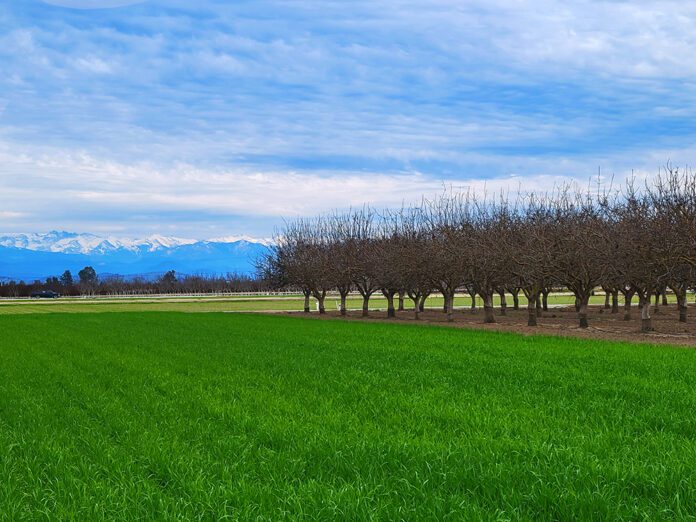
The California pistachio breeding program was initiated by Joe Maranto, Dan Parfitt and Craig Kallsen, and today it continues under Pat J. Brown and Giulia Marino with assistance from many CE specialists and farm advisors and funding from the California Pistachio Research Board (CPRB). The basic process remains the same: choosing parents to cross, initial evaluation of progeny in densely planted blocks of own-rooted Pistacia vera seedings and more rigorous evaluation of selected individuals in grafted orchards with replication at commercial spacing. Today, molecular information can be used to predict traits and discard seedlings before they ever get planted. For example, a sex marker is currently used to discard some (but not all) male seedlings. This article discusses some of the major breeding targets for future pistachio scion cultivars.
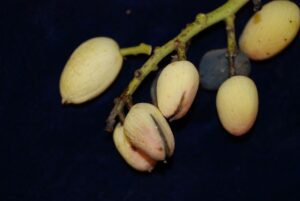
Resistance to Navel Orangeworm, Reducing Early Splits
Navel orangeworm (NOW) is a serious pest of pistachio. NOW larvae feed on developing kernels and can spread Aspergillus fungi, including strains that produce aflatoxin, a known carcinogen. NOW infestation requires both a breach in the hull and a split shell, and most aflatoxin accumulation in pistachios occurs in nuts that are “early splits.” In these nuts, both the hull and the shell split simultaneously and prematurely before separation of the hull from the shell and long before harvest (Figure 1), resulting in a characteristic suture stain after hulling and drying (Figure 2). Early splits allow NOW moths to oviposit along the split, often bringing Aspergillus with them. Tiny larvae from the hatched eggs then have direct access to the kernel to feed, grow and become pupae, and aflatoxigenic fungi have ample time for kernel infection and aflatoxin accumulation. The formation of early splits is affected by irrigation management. Lapses in irrigation early in the season, particularly in May, when the shell is rapidly expanding increase the proportion of early splits later in the season.
Different pistachio varieties in the same orchard show variation in the proportion of early splits despite receiving the same irrigation. Is this because their hulls are more resilient, or simply because the timing of their shell and kernel development was better aligned with the irrigation they received? This information will determine whether it is possible to breed new cultivars with reduced incidence of early splits. In Kerman pistachios, a positive correlation was observed between normal split incidence and the incidence of early splits across orchards (r2=0.43; Figure 3), illustrating the quandary of the pistachio breeder: Is it possible to reduce early splits without reducing normal split incidence at harvest? Conversely, has breeding for cultivars with high split incidence inadvertently led to higher levels of early splits?
Unsplit nuts, resulting from either late pollination or insufficient heat units, are effectively protected from NOW and aflatoxin accumulation, though kernel size is generally reduced. Some varieties with large kernels yield exclusively unsplit nuts, which demand a much lower price than split nuts, and these varieties are generally discarded during the selection process. An ideal variety would show high levels of split nuts at harvest, low levels of early splits mid-season, and rapid shell hardening early in the season. Rapid shell hardening would help protect from stigmatomycosis, a disease caused by a yeast, Eremothecium coryli, that is injected into the kernel during feeding by leaffooted bug and other large hemipteran insects, including stinkbugs.
Since reducing early splits might have undesirable effects on other nut traits, alternative solutions for increasing NOW resistance may be needed. NOW is a highly mobile insect that is thought to migrate to pistachio trees using olfactory cues. One possibility would be to identify and eliminate the volatile compounds that attract NOW.
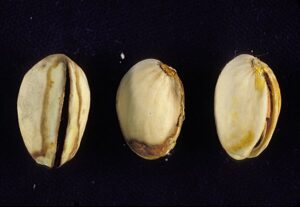
Reducing the Proportion of Blank Kernels
Pistachios are unique in that the shell expands rapidly to full size, but a portion of the nuts are “blanks” at maturity and do not contain kernels. Blank pistachio nuts appear to result from both parthenocarpy (shell/hull development without fertilization) and from embryo abortion, though in practice it is difficult to distinguish parthenocarpy from very early embryo abortion. Blank kernels are a developmental quirk of pistachio that may have evolved as a means of deterring would-be seed predators.
The proportion of blanks on a pistachio tree in each season is affected by genetics, physiology and management. Poor pollination, stress and low carbohydrate storage during an ‘off’ year may all increase the proportion of blanks. However, even in a close-to-perfect year, pistachio trees will have blanks, and the proportion of blanks will be different between cultivars. One of the strengths of Golden Hills over Kerman is that it has fewer blanks; in contrast, Pete 1 fell out of favor as a cultivar because it has more blanks than Kerman. We do not yet understand why some females consistently have more blanks than others. Is it related to general stress resistance, cluster size or carbohydrate storage capacity? Do the male pollenizer cultivars affect the proportion of blanks? We need more data to answer these questions simply because blanking is affected by so many factors.
Reducing the Winter Chill Requirement
Perhaps the most obvious threat to pistachio production in California is our declining winter chill, which leads to weak and straggled bloom. Deciduous trees like pistachio use a sophisticated timing mechanism to decide when to break dormancy in the spring. First, endodormancy is gradually eroded by winter chill. Once endodormancy has been broken, ecodormancy is broken by the accumulation of favorable growth conditions (warmth). Because the endodormancy and ecodormancy requirements vary between pistachio cultivars, the unique weather patterns in each dormant season give rise to differences in spring bloom order and timing among cultivars. This makes it a challenge to choose a single male pollenizer for a female cultivar (multiple males are generally better.)
Each individual in the breeding program begins as a single seedling tree for which we can measure leafing and bloom dates once per year. To gather more detailed information on chill requirement from these unique individuals, we gather dormant sticks from them at biweekly intervals through the winter and force them in tubs of water in a warm greenhouse. Sticks collected later in the winter break bud progressively more quickly in the greenhouse as their endodormancy requirement is satisfied. This dormant stick assay allows us to begin to separate the endodormancy and ecodormancy requirements of each individual and match males and females that are expected to bloom at similar times across all conceivable weather scenarios.
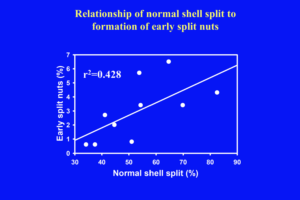
Maintaining Yield with Reduced Water Quality and Quantity
Decreasing water availability and increasing water regulation create challenges for tree nut growers. Pistachio is a resilient species that can survive periods of drought, but it needs regular irrigation to grow a crop that can provide economic returns. Deficit irrigation during shell development may lead to early splits, and deficit irrigation during kernel development may lead to unsplit nuts. For this reason, we should expect that different cultivars will be resilient to lapses in irrigation at different stages of nut development. Pistachio also tolerates relatively high levels of dissolved salts (Na+, Cl- and B) that are usually toxic to other crop species, but again, there is variation between cultivars, with Golden Hills apparently more sensitive to boron than Kerman. We know pistachio rootstocks (UCB-1 seedlings specifically) differ in their ability to sequester salts in their wood. If the same is true for pistachio scions, this could account for the differences observed between Golden Hills and Kerman.
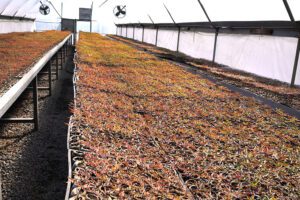
Putting It All Together into a Cultivar that Works
A fundamental challenge of breeding is to combine valuable traits from multiple sources into a single cultivar that is (hopefully) free of fatal flaws. This process is especially challenging in dioecious pistachio since we cannot observe nut traits directly in prospective male parents. In dairy cattle, this problem was solved by keeping careful pedigree records to infer the ‘milk yield of a bull’ indirectly from the performance of its daughters. We can now use molecular information to accelerate this process in pistachio. The ability to induce male flower formation on female cultivars using plant growth regulators, though not yet possible, would also be of tremendous benefit to the pistachio breeding process. To turn CPRB’s grower-funded investment in the breeding program into new cultivars that bring value to growers, there is much to do and no time to waste.















